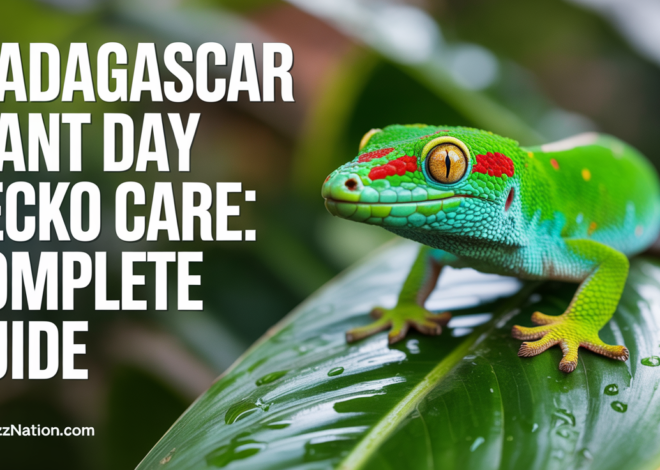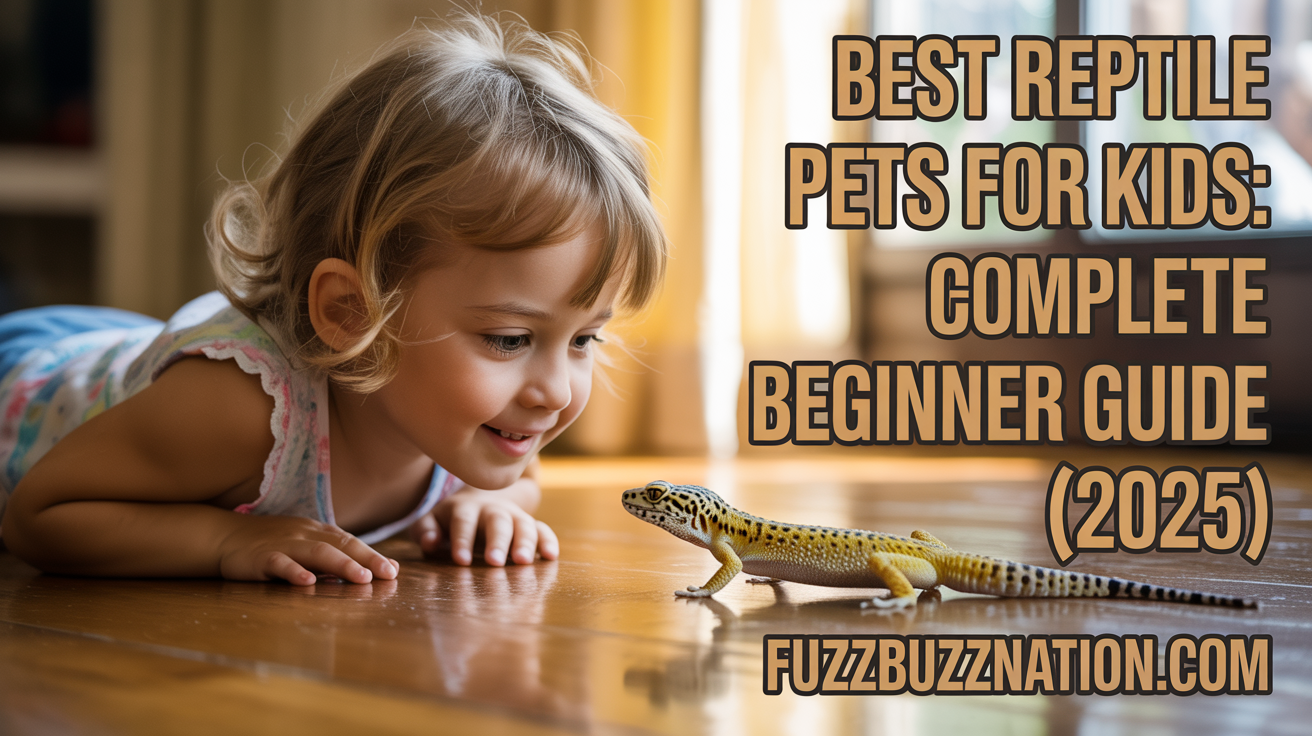
Best Reptile Pets for Kids: Complete Beginner Guide (2025)
The best reptile pets for kids are leopard geckos, bearded dragons, and crested geckos because they’re docile, hardy, and forgiving of beginner mistakes. Leopard geckos lead the pack with their calm temperament, simple care requirements, and tolerance to handling, making them perfect first reptiles for children as young as eight years old. Bearded dragons follow closely as interactive, personality-filled lizards that thrive with proper care, while crested geckos offer a slightly smaller, lower-maintenance alternative that’s ideal for younger children or those with limited space.
Over the past decade working with families and their first reptile pets, I’ve seen the magic that happens when a child successfully cares for a living creature with scales instead of fur. I’ve also witnessed the heartbreak when families choose the wrong species, leading to stressed animals, overwhelmed kids, and expensive emergency vet visits. The difference between a rewarding experience and a disappointing one usually comes down to selecting an appropriately kid-friendly species and understanding what “easy care” really means in the reptile world.
Why Reptiles Make Surprisingly Perfect Pets for Children
Teaching Responsibility Without Overwhelming Daily Demands
Reptiles offer unique advantages that make them exceptional teaching tools for responsibility-minded parents. Unlike puppies that need multiple daily walks and constant supervision, most beginner reptiles require feeding only every other day or a few times weekly. This manageable commitment allows children to learn pet care fundamentals without feeling buried under endless tasks. The structured, predictable nature of reptile care teaches kids about routine and consistency while leaving plenty of time for homework, sports, and other activities.
I’ve watched countless families successfully use reptile ownership as a stepping stone toward more demanding pets. Eight-year-old Emma started with a leopard gecko, learned to maintain feeding schedules and clean habitats reliably, and three years later confidently took on caring for the family dog. That progression wouldn’t have worked with a high-maintenance pet right from the start.
The Space and Cost Advantages Nobody Tells You About
A properly set up reptile habitat typically requires just two to four square feet of floor or shelf space, making them apartment-friendly and perfect for families without yards. Compare this to dogs needing outdoor access and cats claiming entire rooms as their territory. The initial habitat setup does require investment ranging from 150 to 400 dollars depending on species, but monthly costs afterward usually run just 20 to 40 dollars for food, electricity, and occasional supplies.
This relatively modest financial commitment means families can provide excellent care without breaking the bank. When unexpected expenses arise (and they do with all pets), reptile vet visits typically cost less than treating dogs or cats. Many reptile emergencies can also be prevented entirely through proper habitat maintenance, something kids can actively participate in and learn from.
The Allergy-Friendly Factor for Sensitive Families
Reptiles produce no dander, require no grooming that releases allergens, and create virtually zero respiratory irritation for family members with pet allergies. This opens pet ownership possibilities for children who’ve always wanted animals but couldn’t tolerate traditional furry companions. The enclosed habitat also contains any potential allergens from substrate materials, creating an additional protective barrier.
However, reptiles do carry salmonella bacteria naturally on their skin, making proper hand washing after handling absolutely essential. This hygiene requirement actually provides an excellent teaching opportunity for young children learning about germs and cleanliness protocols.
Leopard Geckos: The Gold Standard for First-Time Reptile Kids
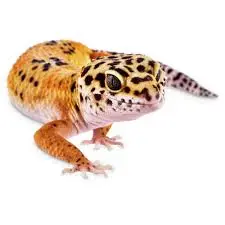
Why Leopard Geckos Consistently Top Every Expert List
Leopard geckos have earned their reputation as the perfect beginner lizard through decades of successful pet keeping worldwide. Their calm, docile temperament makes them remarkably tolerant of gentle handling by children, and they rarely bite even when startled. Unlike many reptiles that remain skittish forever, leopard geckos actually enjoy interaction with their owners once they’ve bonded, often approaching the glass when they see their favorite person approaching.
These geckos reach a manageable adult size of eight to ten inches including the tail, making them substantial enough to handle confidently without being intimidatingly large. Their sturdy build means they can withstand the occasional clumsy handling that happens when kids are learning proper technique. Most impressively, leopard geckos live 10 to 20 years with proper care, providing a long-term companion that grows up alongside your child.
Setting Up a Leopard Gecko Habitat Kids Can Actually Maintain
Creating an appropriate leopard gecko home costs between 150 to 250 dollars initially but remains straightforward enough for children to help maintain. A 20-gallon tank (24 inches long) provides ample space for one gecko, though a 30-gallon long tank works even better. The habitat needs three hiding spots (one on the warm side, one on the cool side, and one humid hide for shedding), along with a shallow water dish and climbing decorations.
Temperature management requires a heat mat or under-tank heater controlled by a thermostat to maintain a warm side temperature of 88 to 92 degrees Fahrenheit, with the cool side staying around 75 to 80 degrees. This temperature gradient lets your gecko self-regulate body temperature, a concept kids find fascinating to observe. Unlike many reptiles, leopard geckos don’t require expensive UVB lighting, significantly reducing both initial costs and ongoing complexity.
Substrate choices for leopard geckos spark heated debates in reptile communities, but for kids just starting out, paper towels, reptile carpet, or tile provide the safest, easiest options. These substrates eliminate impaction risks from accidental ingestion while making spot-cleaning simple enough for children to handle independently.
The Feeding Routine That Builds Confidence
Leopard geckos eat live insects exclusively, which initially concerns some parents but actually provides engaging, educational feeding experiences. Juvenile geckos eat every day, while adults thrive on feedings every other day, creating a manageable schedule that teaches kids about nutritional needs changing with age. Each feeding involves offering appropriately sized crickets, dubia roaches, or mealworms dusted with calcium powder.
The feeding process becomes a highlight for most kids. Watching their gecko stalk and capture prey satisfies natural curiosity about predator behaviors while demonstrating the hunting skills these animals possess. Most children quickly overcome any squeamishness about handling insects when they see their pet thriving on this natural diet.
The One Critical Thing Most Guides Skip About Gecko Tails
Leopard geckos possess a self-defense mechanism called autotomy, allowing them to voluntarily drop their tails when grabbed or severely stressed. While the tail regrows, it never looks quite the same as the original, often appearing shorter and stubbier. This adaptation requires families to teach children proper handling techniques from day one: never grab the tail, always support the gecko’s body with both hands, and avoid sudden movements that trigger defensive responses.
The tail-dropping ability shouldn’t scare families away from leopard geckos. With proper handling instruction and supervision, tail loss rarely occurs. In fact, explaining this biological defense mechanism often fascinates children and motivates them to practice gentle, respectful handling consistently.
Bearded Dragons: The Interactive Reptile With Personality for Days
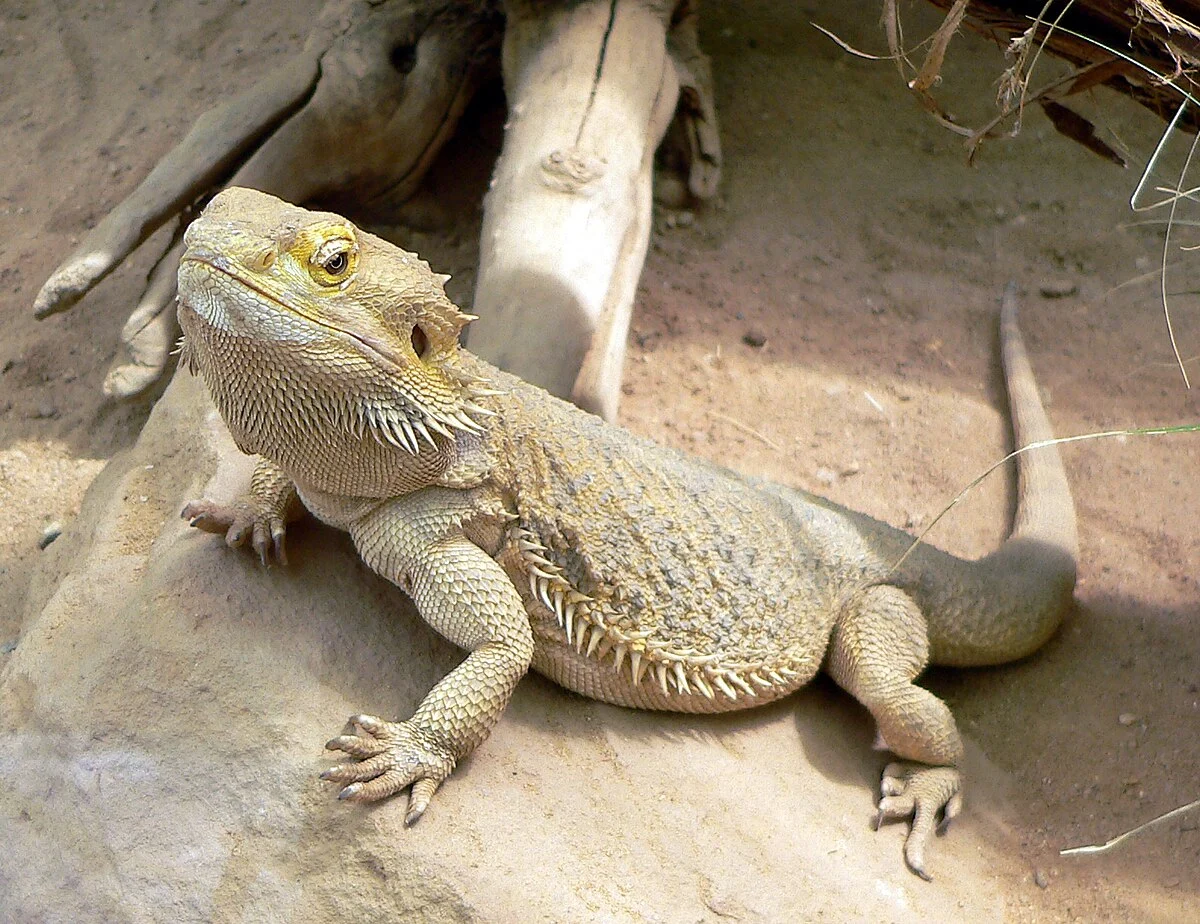
What Makes Bearded Dragons the Most Dog-Like Lizard
Bearded dragons consistently surprise new owners with their remarkably social, engaging personalities. These Australian natives actually seem to recognize their owners, often running to the front of their enclosure when familiar people approach. Many bearded dragons enjoy being hand-fed, will perch contentedly on shoulders during supervised time outside their habitat, and even respond to their names with practice and patience.
This interactive nature makes bearded dragons especially rewarding for children who want a pet they can truly bond with rather than just observe. I’ve watched kids spend hours watching their beardies bask, hunt insects, and perform amusing head-bobbing behaviors that serve as communication. The connection formed between child and bearded dragon often runs deeper than with less social reptile species.
The Commitment Level Parents Need to Understand
Bearded dragons require significantly more complex care than leopard geckos, making them better suited for children aged 10 and older or younger kids with very hands-on parental involvement. These lizards grow 18 to 24 inches long and need spacious enclosures, with 40 gallons being the absolute minimum and 75 to 120 gallons recommended for adult dragons. This larger habitat requires more cleaning effort and physical space in your home.
The setup complexity increases substantially compared to simpler species. Bearded dragons absolutely require UVB lighting to prevent metabolic bone disease, a devastating condition caused by calcium metabolism problems. The UVB bulb needs replacing every six to twelve months depending on type, adding ongoing costs. Temperature requirements are also more demanding, with basking spots needing to reach 100 to 110 degrees Fahrenheit for proper digestion, while maintaining a cool side around 75 to 85 degrees.
The Dietary Flexibility That Appeals to Kids
Bearded dragons are omnivores with dietary needs that change dramatically as they age. Juveniles eat primarily insects (about 70 percent) with some vegetables, while adults flip this ratio, consuming mostly vegetables (about 70 percent) with occasional protein. This varied diet means kids get to participate in both feeding live insects and preparing fresh salads daily, teaching nutrition concepts and food preparation skills.
The vegetable preparation aspect actually helps picky eaters understand nutrition better. Many parents report their children becoming more interested in vegetables after learning which greens provide essential nutrients for their bearded dragon. Watching a beardie demolish a salad of collard greens, butternut squash, and bell peppers sometimes inspires kids to try these foods themselves.
The Reality Check About Bearded Dragon Bugs
Here’s what many guides gloss over: feeding a bearded dragon properly requires maintaining your own colony of feeder insects or making frequent pet store runs. Juvenile bearded dragons can consume 50 to 80 small crickets or dubia roaches daily, representing significant ongoing costs and effort. Some families find establishing roach colonies works well, while others prefer the convenience of pet store visits despite higher per-insect costs.
The insect feeding commitment isn’t just about purchasing bugs. Each feeder insect needs “gut loading” (feeding nutritious foods) for 24 hours before offering them to your dragon, then dusting with calcium and vitamin supplements at feeding time. This multi-step process teaches kids about nutritional chains and the importance of proper supplementation, but it also represents real work that must happen consistently.
Crested Geckos: The Easiest Reptile Pet Almost Nobody Recommends First
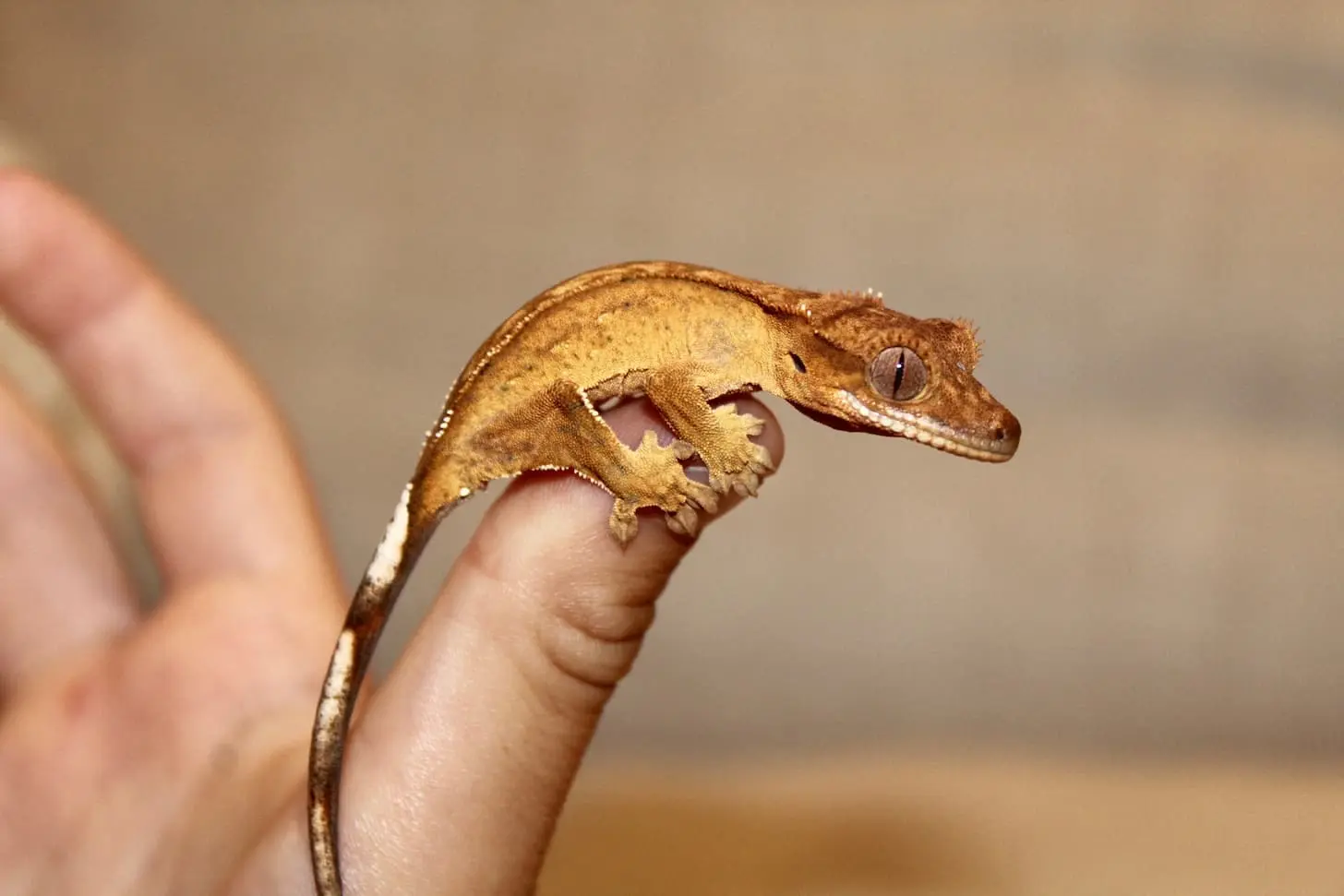
Why Crested Geckos Deserve More Recognition
Crested geckos fly under the radar in beginner reptile discussions, yet they offer some of the easiest care requirements in the entire hobby. These charming geckos from New Caledonia reach just six to ten inches long, making them perfect for younger children or families with very limited space. Their sticky toe pads allow them to climb glass surfaces effortlessly, creating entertaining displays as they navigate their arboreal habitats.
The crowning feature that makes crested geckos exceptional for kids is their dietary flexibility. Unlike most reptiles requiring live prey, crested geckos thrive on commercially prepared powder diets mixed with water into a smoothie-like consistency. This eliminates the need for insect keeping entirely, though many owners supplement with occasional live insects as treats. The powder diet approach removes one of the biggest barriers preventing families from reptile ownership: dealing with live feeder insects.
The Vertical Habitat That Saves Floor Space
Crested geckos need vertical space rather than floor space, allowing families to house them in tall, narrow enclosures that fit beautifully on desks or shelves. A 20-gallon vertical tank (18 inches tall minimum) provides ample room for one adult gecko. The habitat should include multiple branches at different heights, live or artificial plants for hiding, and a water dish. Many keepers use bioactive setups with live plants and cleaning crews, creating self-maintaining ecosystems that fascinate scientifically-minded children.
Temperature requirements for crested geckos are remarkably forgiving compared to other reptiles. They thrive at normal room temperatures between 72 to 78 degrees Fahrenheit, needing no special heating equipment in most homes. This eliminates concerns about thermostat failures, heating equipment costs, and the fire hazards associated with heat lamps. The only environmental concern involves keeping them below 80 degrees consistently, as prolonged heat stress can cause serious health problems.
The Fragility Factor Every Parent Should Know
While crested geckos offer easy care in many respects, their delicate bodies require gentle handling, making them less forgiving of rough treatment than sturdier species like leopard geckos. Like their leopard cousins, crested geckos can drop their tails when frightened, but unlike leopards, crested gecko tails never grow back. This permanent loss doesn’t affect the gecko’s health but does change their appearance forever.
Young children under seven or eight years old may struggle with the gentle touch required for safe crested gecko handling. These geckos are also quick, jumpy creatures that can launch themselves unexpectedly, leading to falls that may injure both the gecko and startle the child. Families with very young kids might choose to make crested geckos observation pets primarily, saving extensive handling for when children demonstrate appropriate gentleness and patience.
The Nocturnal Schedule Some Families Overlook
Crested geckos are strictly nocturnal, meaning they spend daylight hours hiding and only become active after sunset. This schedule works beautifully for school-aged children who can enjoy evening observation and interaction time. However, families hoping for a pet that’s active during afternoon playtime may find the nocturnal lifestyle disappointing. The nighttime activity also means any habitat noises (jumping, climbing) happen while your household sleeps, though these sounds rarely prove disruptive.
Corn Snakes: When Your Kid Is Ready for Something Slithery
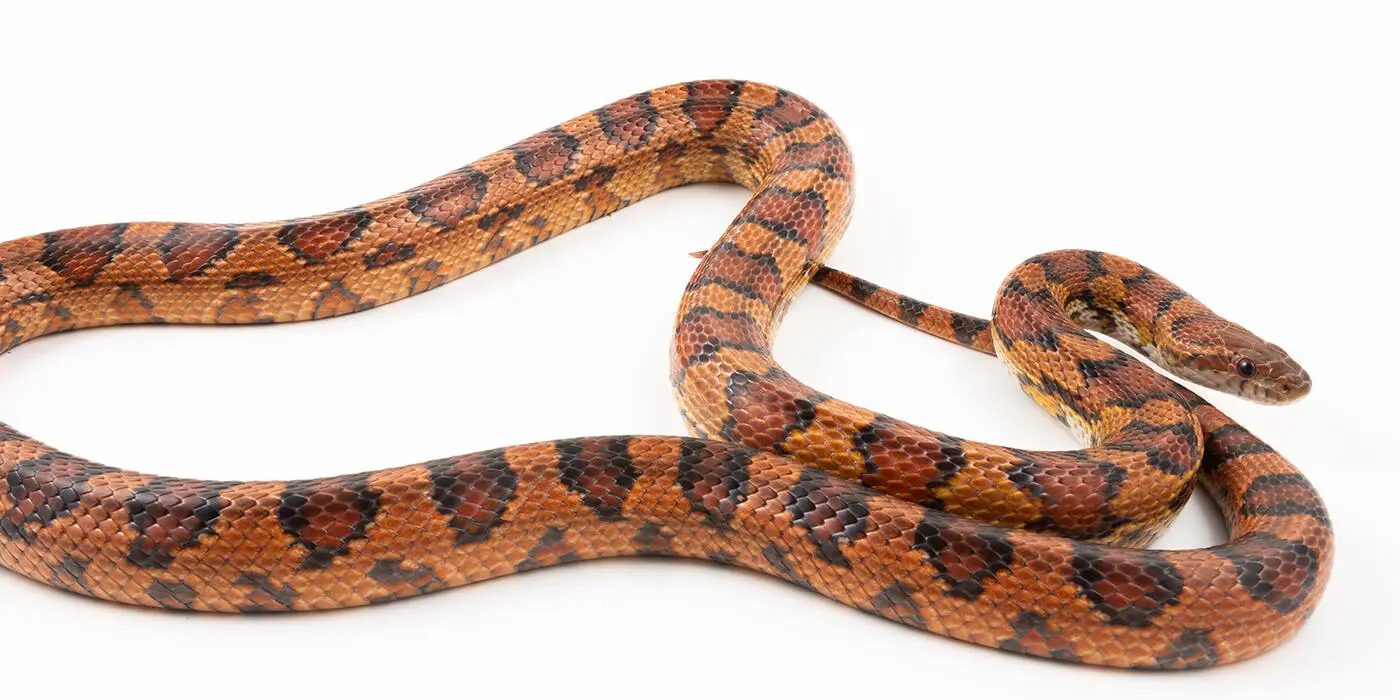
Breaking the Fear Barrier With a Gentle Snake
Corn snakes challenge the stigma surrounding pet snakes with their docile temperaments and beautiful coloration patterns. These North American natives rarely bite, tolerate regular handling well, and actually seem to enjoy exploring their environment during supervised outside-habitat time. For children who’ve expressed specific interest in snakes rather than lizards, corn snakes provide the safest, most beginner-friendly entry point into snake keeping.
Adult corn snakes reach four to six feet long, making them substantial enough to handle confidently without being intimidatingly large like pythons or boas. Their slender body build means even a five-foot corn snake weighs just one to two pounds, easy for older children to support properly. The gradual size increase as they grow from hatchling to adult allows kids to build confidence with handling as both they and their snake mature together.
The Long-Term Commitment Parents Must Consider
Corn snakes live 15 to 20 years in captivity, representing the longest commitment on our beginner reptile list. This longevity means your child’s pet corn snake might accompany them from elementary school through college graduation. While this extended companionship appeals to many families, others find the decades-long commitment daunting, especially if children’s interest in pet care wanes during teenage years.
The space requirements also increase over time. Hatchling corn snakes start happily in 10-gallon enclosures, but adults need minimum 40-gallon tanks with 75 gallons being ideal. The larger adult enclosure represents both a space and financial investment that families should plan for from the beginning, even though it won’t be necessary for several years.
The Feeding Routine That Challenges Some Families
Corn snakes eat pre-killed frozen rodents, typically one appropriately-sized mouse every five to seven days for juveniles and every seven to fourteen days for adults. This feeding schedule means less frequent interaction than daily insect feeding, but the nature of the food challenges some family members. Many people who happily purchase crickets find frozen mice more emotionally difficult, though the prey items come pre-killed and frozen for humane reasons.
The good news is that corn snakes are typically enthusiastic eaters with straightforward feeding requirements. Thaw a frozen mouse in warm water, offer it with feeding tongs, and watch your snake constrict and consume its meal. Many children find the feeding process fascinating from a scientific perspective, offering opportunities to discuss food chains, predator behaviors, and natural ecology. However, families should honestly assess their comfort level with this type of feeding before committing to snake ownership.
Why Corn Snakes Work Best for Slightly Older Kids
The combination of factors makes corn snakes most appropriate for children aged 10 to 12 and older. The extended lifespan requires mature commitment understanding, the feeding routine needs parental involvement initially, and the snake’s length demands proper two-handed support technique. Younger children often struggle with snakes moving independently across their arms compared to geckos who sit relatively still, leading to handling anxiety on both sides.
That said, families with dedicated older children find corn snakes incredibly rewarding. These snakes demonstrate clear individual personalities, with some being adventurous explorers and others preferring to stay hidden. The variety of color morphs available (from natural red and orange patterns to selective bred variations in every color imaginable) adds visual appeal that captivates many young reptile enthusiasts.
Blue-Tongued Skinks: The Underrated Beginner Choice
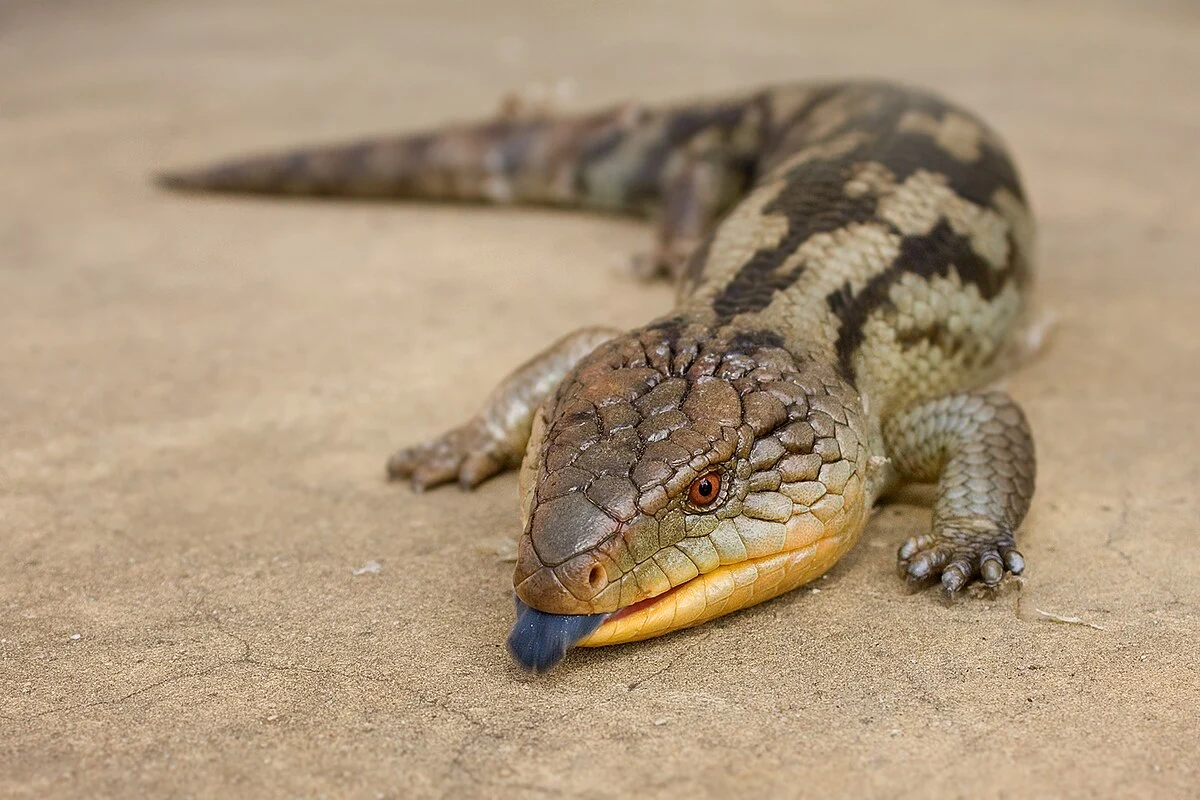
What Makes Blue-Tongues Different From Other Lizards
Blue-tongued skinks represent a middle ground between the simplicity of geckos and the interactivity of bearded dragons. These Australian lizards grow 18 to 24 inches long with stout, chunky bodies and remarkably friendly dispositions once they’ve settled into their homes. Their most distinctive feature, of course, is the bright blue tongue they flash when startled or investigating food, never failing to elicit delighted reactions from children.
Blue-tongues are diurnal (active during daytime), omnivorous, and remarkably hardy, making them forgiving of many beginner mistakes. Unlike skittish species that never truly calm down, blue-tongued skinks tend to become quite docile with regular gentle handling, often seeming to enjoy supervised exploration time. Many develop feeding responses, eagerly approaching when they see their food dishes being prepared.
The Setup That Bridges Simple and Complex
Blue-tongued skink care falls somewhere between basic and intermediate difficulty. They need 40 to 55-gallon tanks minimum, UVB lighting (though not as critical as for bearded dragons), and basking temperatures around 95 to 100 degrees Fahrenheit with a cool side at 75 to 80 degrees. The temperature requirements mirror bearded dragons but blue-tongues prove more forgiving of minor fluctuations.
Substrate choice matters more for blue-tongues than many species because they burrow naturally. Many keepers use cypress mulch, coco fiber, or soil-based substrates allowing natural digging behaviors. This creates opportunities for kids to observe burrowing and learn about how different animals use their environment. However, burrowing substrates require more sophisticated cleaning protocols than simple paper substrates, adding complexity to routine maintenance.
The Diet Diversity That Teaches Nutrition
Blue-tongued skinks eat an omnivorous diet remarkably similar to what humans need nutritionally. They consume a mixture of proteins (insects, cooked lean meats, eggs), vegetables, and fruits, with adult diet ratios typically being 50 percent protein and 50 percent plant matter. This variety means kids can help prepare skink meals while learning about balanced nutrition, often making connections to their own dietary needs.
The feeding frequency for adults (every two to three days) strikes a nice balance between daily feeding demands and weekly schedules. Meal preparation becomes a fun kitchen activity where children can safely handle food prep under supervision, then watch their skink enthusiastically demolish the prepared feast. Many blue-tongues are quite food-motivated, adding an interactive element to feeding time that geckos don’t always provide.
The Size and Longevity Consideration
Blue-tongued skinks live 15 to 20 years and reach substantial sizes, making them long-term commitments requiring dedicated space. Their stocky build means even at 20 inches they feel heavy and solid, requiring children to develop proper two-handed support techniques. This size actually helps with confident handling, as blue-tongues feel secure and substantial rather than delicate and fragile.
However, the size also means higher food costs over time and potential housing upgrades as your skink grows. These lizards are also not as widely available as leopard geckos or bearded dragons, potentially requiring specialized breeders rather than local pet store purchases. The extra effort finding a healthy, well-started blue-tongue often pays off with a remarkably personable pet.
The Reptiles You Should Avoid Despite Pet Store Recommendations
Why Green Iguanas Make Terrible Kids’ Pets
Pet stores frequently sell baby green iguanas as beginner reptiles, capitalizing on their small size, bright coloration, and low initial price. This represents one of the most irresponsible sales practices in the pet industry. Green iguanas grow to six feet long, require enormous custom enclosures costing thousands of dollars, need precisely maintained high humidity and temperature, and often become aggressive during breeding season, potentially inflicting serious bites and whip-like tail strikes.
The dietary requirements also overwhelm most families, requiring daily fresh salads with specific calcium ratios to prevent metabolic bone disease. Even experienced reptile keepers find adult iguanas challenging. For children and families, they represent an almost guaranteed path to rehoming, abandonment, or severe animal welfare problems. Avoid green iguanas regardless of how cute they appear as babies or how convincingly store employees pitch them as “easy” pets.
The Chameleon Trap That Catches Too Many Families
Chameleons captivate with their color-changing abilities and independently moving eyes, making them irresistible to many children. Unfortunately, these animals rank among the most difficult reptiles to maintain successfully. They require specific humidity levels, misting systems or hand-misting multiple times daily, precise temperatures, live plants, and have complex dietary needs including calcium supplementation that’s easy to get wrong.
Most chameleon species are also quite fragile and don’t tolerate handling well, making them observation animals rather than interactive pets. The high-maintenance care combined with their delicate constitutions means even minor husbandry mistakes can quickly become life-threatening. Chameleons belong in the collections of experienced keepers only, never as first reptiles for children.
Small Turtles and Tortoises: Cute but Complicated
Box turtles, red-eared sliders, and small tortoises tempt families with their approachable appearance and perceived low maintenance. The reality involves complex water quality management for aquatic species, very specific temperature and humidity requirements for all species, and dietary needs that prove surprisingly finicky. Turtles and tortoises also live extraordinarily long lives, with many species easily surviving 30 to 50 years, representing commitments that span your child’s entire growing-up years and beyond.
The salmonella risk with turtles is also particularly high, earning them specific CDC warnings against keeping them in homes with young children. While all reptiles carry salmonella potential, turtles present elevated risks requiring vigilant hygiene protocols many young children struggle to maintain consistently.
Setting Your Child Up for Reptile Care Success
The Age-Appropriate Responsibility Framework
Children as young as six or seven can participate meaningfully in reptile care with proper guidance and parental involvement. At this age, kids can help with feeding routines, observing their pet daily for health changes, and simple habitat spot-cleaning tasks. The key involves parents maintaining oversight and handling the complex tasks like temperature monitoring and major tank cleanings while children learn the basics.
Ages eight to ten represent a sweet spot for first reptile ownership, as children can handle more tasks independently while still benefiting from parental supervision and support. They can manage feeding schedules, understand temperature gradient concepts, and often take pride in being primary caregivers with backup support. By age 12 and older, many children can manage nearly all aspects of beginner reptile care, though parents should still monitor welfare and step in when needed.
The Family Meeting That Prevents Future Problems
Before bringing home any reptile, successful families hold honest discussions about responsibilities, costs, and what happens if interest wanes. Creating a written care schedule with specific child and parent responsibilities eliminates confusion and establishes clear expectations. This document should address who handles feeding, cleaning, handling time, health monitoring, and what consequences follow when tasks get neglected.
The conversation should also address the “what if” scenarios honestly. What happens if your child loses interest after six months? Will parents take over care completely, will the family rehome the animal, or will there be expectations that the child continues despite reduced enthusiasm? Having these difficult discussions upfront prevents animals suffering from neglect and families experiencing conflict over unfulfilled commitments.
The Starter Budget Most Guides Underestimate
Plan for initial setup costs of 200 to 400 dollars for beginner reptiles including appropriate habitat, heating/lighting equipment, thermometers, substrate, decorations, and initial food supplies. This investment gets your reptile started right, eliminating the false economy of buying cheaper inadequate equipment that requires replacement later. Many families find success watching for used tank sales, but heating and lighting should always be purchased new for safety reasons.
Monthly costs typically run 20 to 50 dollars covering electricity for heating/lighting, food, substrate replacement, and occasional accessory updates. Budget additionally for annual veterinary checkups (100 to 150 dollars) and emergency vet savings (500 to 1000 dollars) in case health problems arise. While many reptiles never need emergency care, having funds available prevents devastating choices between treatment and euthanasia when problems occur.
The Veterinarian Research Nobody Does Until It’s Too Late
Find a reptile veterinarian before bringing your pet home, not when emergencies strike. Many traditional vets lack reptile experience, and even those willing to see your gecko or bearded dragon may not have appropriate expertise. Search for veterinarians with specific reptile training or board certification in exotic animal medicine. Many areas have limited reptile vet access, potentially requiring drives of an hour or more for appropriate care.
Schedule a new pet checkup within the first week of bringing your reptile home. This wellness visit establishes baseline health, allows your vet to identify any concerns from the breeder or pet store, and starts building a veterinary relationship before problems arise. The cost of this initial checkup (typically 50 to 100 dollars) provides invaluable peace of mind and early detection of hidden issues.
Your Essential Questions About Kids and Reptiles Answered
At what age can kids safely start caring for reptiles?
Children as young as six to seven can begin participating in reptile care with close parental supervision, though the level of responsibility should match their maturity rather than just their age. At this stage, kids can help with feeding, observation, and simple tasks while parents handle complex care requirements and ensure the animal’s welfare. Most experts consider eight to ten the ideal age for primary caregiver responsibilities with parental backup, while children 12 and older can typically manage nearly all aspects of beginner reptile care independently. The specific child’s maturity, reliability with existing responsibilities, and genuine interest level matter far more than arbitrary age cutoffs. Some responsible 10-year-olds provide better care than distracted 15-year-olds, making family assessment crucial.
How much time does reptile care really take each day?
Most beginner reptiles require surprisingly little daily time compared to traditional pets, typically 15 to 30 minutes for feeding days and five to ten minutes on non-feeding days for observation and spot-cleaning. Leopard geckos eating every other day might need just ten minutes most days to refresh water and check for waste, with feeding days adding another ten minutes for insect preparation. Bearded dragons demand slightly more time due to daily vegetable preparation and more frequent feeding schedules. Weekly deep-cleaning sessions add 30 to 60 minutes for thorough habitat sanitization. This time commitment works well for busy families but still provides enough interaction to build responsibility skills and bonding opportunities between child and pet.
Can reptiles actually bond with children or are they just tolerating handling?
While reptiles don’t bond like mammals do, many species including bearded dragons, blue-tongued skinks, and well-socialized leopard geckos do recognize their caregivers and display individual personalities. Reptiles may not feel affection in ways we recognize, but many become comfortable with regular handlers, will approach familiar people, and show food-motivated excitement when their primary caregiver appears. The bonding experience from a child’s perspective proves very real regardless of what the reptile experiences internally. Watching their pet recognize them, respond to handling positively, and thrive under their care creates powerful connections that teach children about interspecies relationships and responsibility. The key involves teaching children to read reptile body language and respect when their pet needs space rather than expecting dog-like enthusiasm for interaction.
What happens if my child loses interest in their reptile?
Parent readiness to become primary caregiver represents a crucial decision point before purchasing any reptile, as many children experience waning interest over months or years. Families should establish upfront agreements about what happens when enthusiasm drops, whether parents will assume full care, the pet will be rehomed through responsible channels, or the child faces consequences for neglecting responsibilities. The healthiest approach involves parents viewing themselves as backup caregivers from day one, willing to step in if needed while encouraging continued child participation through positive reinforcement rather than punishment. Many families find that even when daily enthusiasm fades, children still value their reptile and participate meaningfully when care is gamified or when parents model continued interest. Rehoming should be considered only after genuine efforts to reignite interest, and never involves releasing reptiles into the wild or surrendering to potentially substandard situations.
Are there any reptiles that don’t need live insects?
Crested geckos represent the only commonly available beginner reptile that thrives without any live insect feeding, subsisting happily on commercially prepared powder diets mixed with water. Blue-tongued skinks can also eat omnivorous diets including cooked proteins and eggs, significantly reducing though not eliminating insect requirements. For families completely opposed to keeping and feeding live insects, crested geckos offer the best solution while still providing engaging pet experiences. However, many initially squeamish families find they adjust quickly to insect feeding once they see how naturally their pet responds to live prey and how educational the process becomes. Starting with less mobile feeders like mealworms or dubia roaches (which don’t jump like crickets) helps ease the transition for uncomfortable family members.
Making the Final Choice: Matching Reptile to Your Family
The best reptile for your child depends less on which species ranks highest on expert lists and more on your family’s specific situation. A responsible 12-year-old with patient, detail-oriented tendencies might thrive with a bearded dragon’s complex care, while an enthusiastic but easily distracted eight-year-old would succeed better with a leopard gecko’s straightforward requirements. Assess your child’s current responsibility track record with existing tasks, their genuine sustained interest in reptiles (not just a passing phase), and your own willingness to provide backup support and supervision.
Consider also your home environment, available space for appropriately sized habitats, and family comfort levels with various aspects of reptile care. A family living in a consistently warm climate might find temperature management easier than those in cold regions requiring expensive heating. Homes with existing insect phobias should lean toward crested geckos, while families comfortable with insects have more options. The time available for daily care, budget for setup and ongoing costs, and long-term commitment capacity all factor into making choices that set everyone up for success.
Remember that reptile keeping offers remarkable opportunities for children to develop responsibility, learn scientific concepts through hands-on experience, and form connections with animals dramatically different from themselves. The key to positive experiences lies in honest assessment, appropriate species selection, proper education before purchase, and realistic expectations about both the joys and challenges ahead. When families approach reptile ownership thoughtfully and prepare adequately, these scaly companions provide years of learning, growth, and genuine companionship that shapes children’s relationships with the natural world.


